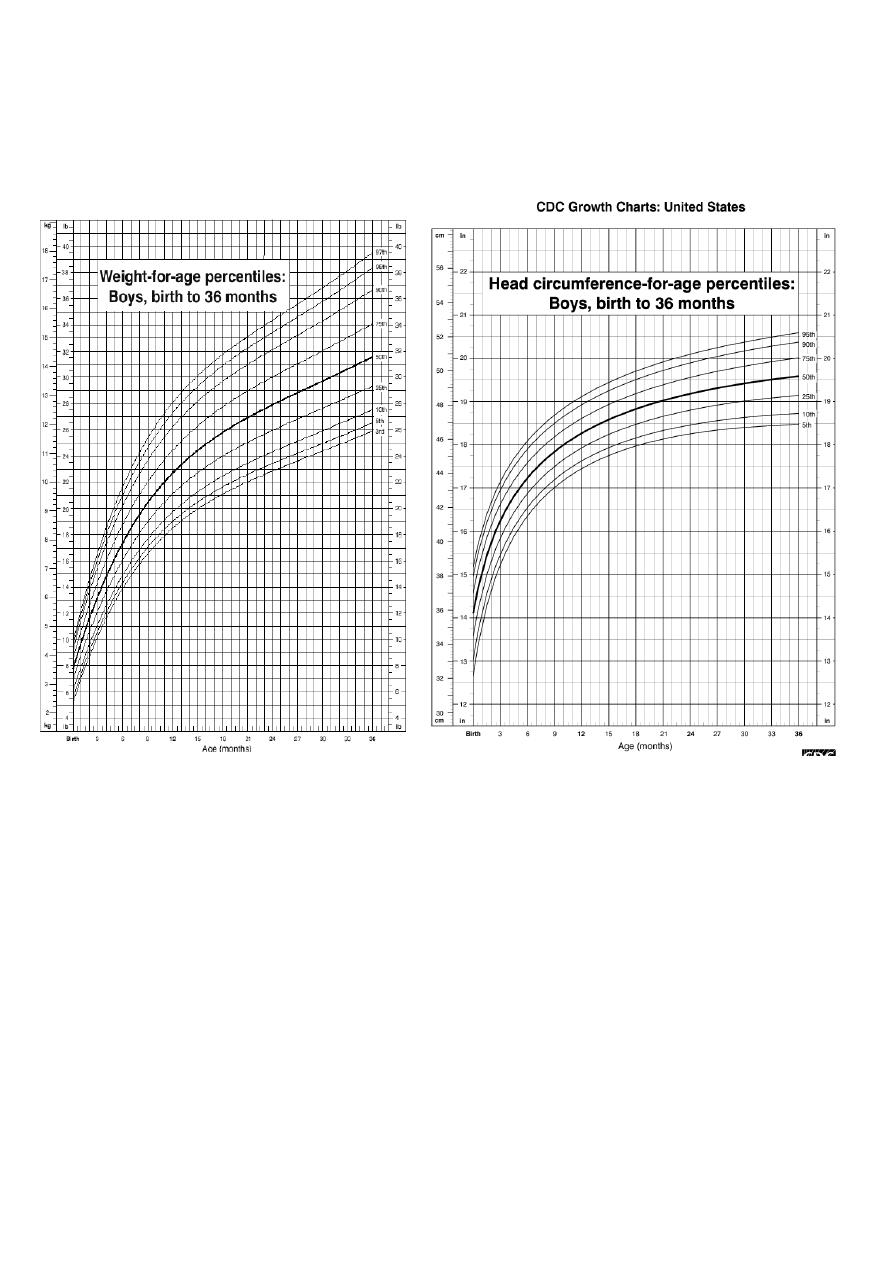
1
Fifth stage
Pediatric
Lec-9
.د
بسام
29/2/2016
GROWTH AND DEVELOPMENT
Growth: is increase in size of the body or quantitative growth leading to physical maturation.
Development: is maturation of function or qualitative growth leading to mental maturation.
The factors affecting growth and development are the following:
1.
Host or genetic factors like genetic make up (genotype).
2. Physical expression (phenotype).
3. Demographic factors like race and sex or gender.
4. Nutritional factors like maternal nutritional status, breastfeeding and weaning,
complementary feeding practices, diet during illness, supplementary feeding.
5. Environmental factors like socio-economic status.
6. Physical factors like climate, pollution.
7. Biological factors like infections, exercise, drugs and chemicals.
8. Emotional factors like mother infant bonding, parent child interaction, family harmony,
stimulation and tender loving care.
9. Antenatal, natal and postnatal factors like infections, irradiation, drugs and placental
insufficiency affect the potential for growth and development to a great extent.
GROWTH
Stages of Growth
The different stages of growth are:
1. Ovum (0-14 days),
2. Embryo (2-9 weeks),
3. Fetus (9 weeks-birth),
4. Nowborn (0-7 days)
5. Neonate (first 28 days of life),
6. Infant (first year of life),

2
7. Toddler (1-3 years),
8. Preschool child (3-5 years),
9. School child (5-9 years)
10. Adolescence is divided into prepubertal, pubertal and post pubertal stages (10-19 years)
Growth of Different Tissues:
Different tissues grow at different rates. Somatic growth of the body is very fast in the first 2
years of life and then it slows down.
The second spurt is seen in adolescence and then it practically stops.
Brain growth is maximum in the first two years of life and then it slows down. It becomes
almost 80% of the adult size by two years of age and body growth is up to 20%.
Lymphoid growth especially of the tonsils and lymph node picks up slowly and peaks before
puberty and then it slows down.
Gonadal growth is noted around puberty only.
Newborn Growth
-The newborn has around 3 Kg weight (2.5-4 Kg) and 50 cm length (45-55cm).
-The head circumference is 35 cm (33-37 cm).
-The midpoint of the body is umbilicus unlike pubic symphysis in the adult.
-The upper segment to the lower segment ratio from the vertex to pubic symphysis and the
pubic symphysis to the heels respectively is 1.7:1.
-Most newborns lose up to 10% weight initially and regain birth weight by 10 days.
-The weight gain is around 200 g/week in the first 3 months, 150 g/week in the next 3 months
and 100 g/week in the next 6 months.
The birth weight doubles by 5 months, triples by one year, quadruples by two years.
Thereafter 2 kg is added on every year till six years and thereafter 3 kg is added on every year
till puberty.
The birth length is 50 cm; it becomes 66 cm by 6 months, 75 cm by 1 year and 87 cm by 2
years. It doubles by 4 years and thereafter 6 cm is added on every year till puberty. Birth
length triples by 12 years.
The head circumference at birth is 35 cm, it increases to 40 cm by 3 months,43 cm by 6
months, 45 cm by 9 months, 47 cm by one year, 49 cm by two years and 50 cm by 3 years.

3
The approximate increase is 2.0 cm/month is the first 3 months, 1 cm/month in the next 3
months and 0.5 cm/month in the next 6 months.
Growth Chart
DEVELOPMENT
Teeth Development:
The temporary, deciduous or milk set has 20 teeth (8 incisors, 4 canine and 8 molars). These
appear by two and a half years of age. The first tooth appears by 5-9 months. By 1 year of
age, 6-8 teeth are present. In the permanent set, there are 32 teeth including 8 incisors 4
canines, 8 premolars and 12 molars and the first molars appear by 6 years.
Eruption of the second molar marks puberty.
The eruption of the third molar (Wisdom tooth) is variable and occurs after 18 years of age.

4
Development occurs in four areas namely:
-Gross motor.
-Fine motor.
-Language.
-Social.
Gross Motor:
A newborn has head lag on pulling to sitting position. In ventral suspension, the head and the
limbs are flexed.
By 3 months, the head lag is minimal when pulled to sitting position. The baby can raise the
chin in prone position. On ventral suspension, the head are in line with the body.
By 4 months, the baby has head control when held up. In prone position, the baby can raise
the head and shoulder.
By 5 months, the baby bears weight on the forearm in prone position and can bear weight
on standing, also rolling over can be seen at this age.
By 6 months, the baby bears weight on hands in prone position.
By 7 months, the baby can sit with support and lean forward and also bounce on standing.
By 8 months, the baby crawls on the abdomen, and can sits without support.
By 10 months, most of the babies pull to standing posture and walk holding on to a piece of
furniture. This is called “cruising”, they can crawl.
By 1 year, the baby can make a few steps with support.
By 15 months, the baby can walks alone.
By 18 months, the baby can runs.
By 24 months, the baby can climb stairs two feet per step and the baby can also kick a ball.
By 3 years, the baby can climb stairs 1 foot per step and can ride a tricycle.
By 4 years the baby can climb down stairs one foot per step.
By 5 years, the child can skip.
Fine Motor:
The newborn can focus on objects.
By 1 month, the baby can follow objects for up to 90º and for 180 degrees by 2 months.

5
By 4 months the baby can hold objects with both hands and take them to the mouth.
By 5 months, the baby can take the feet to the mouth.
By 7 months, the baby can transfer objects from hand to hand and having a palmar grasp.
By 9 months, the baby can hit two cubes together, can drink by a cup
By 10 months, the baby has a “pincer grasp” by approximating the thumb and the index finger
and can uncover hidden things.
By 1 year, the baby can release objects on request and can make a tower of two cubes.
By 13 months, the baby can turn pages of a book, two to three pages at a time.
By 15 months, the baby can feed self with a spoon without much spilling.
By 18 months the baby can build a tower of 3 cubes.
By 2 years, the baby can turn page by page, and can build a tower of
6 cubes also he can scribble lines.
The baby can draw a circle by 3 years, a square by 4 years and a triangle by 6 years.
Baby can dress and undress alone by 4 years.
Language Development:
Baby makes cooing sounds by 3 months.
By 4 months, the baby can babble.
By 7 months the baby responds to his/her name.
By 7-8 months, baby vocalizes monosyllables.
By 10 months combines monosyllables, and understands spoken speech.
By 1 year, the baby speaks 2-3 words with meaning.
By 18 months, one can speak 20 words.
By 2 years baby can speaks about 200 words and can make a 2 words sentence.
Personal Social Development:
The baby regards faces by 1 month, has social smile by 6 weeks and recognizes the mother
and caretakers by 3 months, can laugh loudly by 4 months.
The baby enjoys looking at the mirror by 6 months and imitates other by 1 year.

6
By 6 months, the baby shows sadness when mother leaves and has stranger anxiety by 8
months.
By 9 months, the baby can drink from a cup and by 15 months the baby can self feed with a
cup and a spoon with little spilling.
By 10 months baby can wave bye bye.
The baby starts toilet training by around 2 years, being dry during day by around 3 years.
Bowel control is before urine control, and girls can control before boys.
By 2 years of age, baby refers to self as “ I “
By 3 years, the baby also has gender identity.
